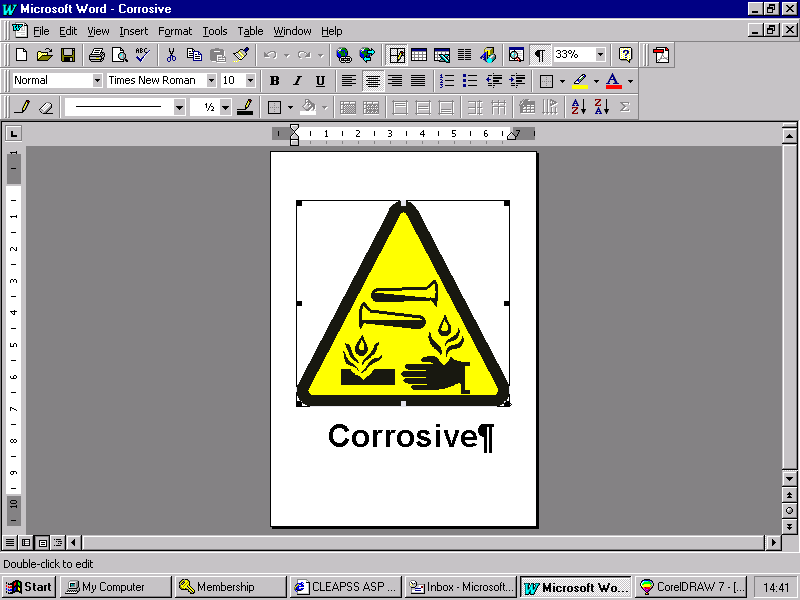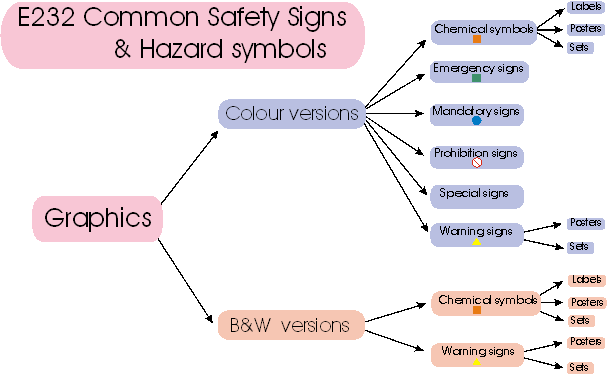
E232
Common Safety Signs & Hazard Symbols
October 2006
Strictly Confidential
Circulate to members and associates only
As with all CLEAPSS publications, members and associates are free to copy all or part of this material for use in their own establishments.
Information about the contents of the various folders that make up this material is given in a summary sheet at the end of this file. It may be helpful to print out a copy of this information prior to attempting to locate the particular images that you require.
CLEAPSS
The Gardiner Building
Brunel Science Park
UB8 3PH
Tel: 01895 251496
Fax: 01895 814372
E-mail: science@cleapss.org.uk
Web site: www.cleapss.org.uk
E232 Common Safety Signs & Hazard Symbols
Please note - You may view the HTML summary sheets using your browser but the quality will not be as good.
|
|
|
|
|
|
|
|
|
|
|
|
|
|
|
|
|
|
|
|
|
|
|
|
|
|
|
|
|
|
|
|
|
|
|
|
|
|
|
|
|
|
|
|
|
|
|
|
|
|
|
|
|
|
||
|
|
|
|
|
|
|
|
|
|
|
|
|
|
|
|
|
|
|
|
|
|
||
|
|
|
CLEAPSS frequently receives requests for details of suppliers of commonly-used safety signs and symbols. As a service to members we have produced our own versions of these signs and symbols and collected them together in the form of this electronic publication. Member schools can print out copies directly from these files using a suitable computer and printer, rather than relying on photocopying. This avoids the degradation in quality that so often leads to disappointing results.
Many of the illustrations have been taken from existing CLEAPSS publications, enhanced and supplemented to provide a more complete coverage.
All images are provided as Word for Windows files that print out as A4-sized posters. Two other sets of files are also included for some of the more commonly-used signs and symbols – one that prints out as sheets of 24 smaller images and another that gives sheets of up to 50 symbols that can be cut up and used as labels. Users can also use ‘Word’ to size, copy and paste the images into their own documents. Since they are based on vector images they do not become degraded at high enlargements.
All signs without text should be used with appropriate supplementary text added to the Word document in which the sign is placed.
2. Scaling and modifying the materials
For those without much experience of scaling pictures in ‘Word’ the following steps are all that are required.

3. Contents
Five types of sign or symbol are included in this collection.
Files are arranged in two versions, a coloured series and a black and white (B&W) set. The colour series includes the full range of signs; the B&W set does not include signs for which colour is an essential part of their composition (ie, emergency, mandatory and prohibitive signs). Colour files will, of course, also print out on a black and white printer, but the background colour of chemical symbols and warning signs degrades the quality of the resulting printout. This is why separate black and white versions of these signs and symbols are included.
Please Note The images in this document are only thumbnails of the images and do not represent the quality of the images in the ‘Word’ document files or the ‘Windows Meta Files’ (WMF) graphic files; they should not be used as the source of the material that you require.
Warning signs
These are used on rooms, equipment and containers. Two versions of each sign are given – ‘Posters’ and ‘Sets’. Each ‘Poster’ file prints out as a single image on A4 paper. A summary sheet of all the signs is also included. Each file in ‘Sets’ prints as an A4 sheet containing 24 identical images.
The following images are included.
|
Biohazard |
Corrosive |
Risk of electric shock |
Explosive |
|
Extremely flammable |
Highly flammable |
Harmful |
Irritant |
|
Danger |
Laser beam |
Oxidising |
Non-ionising radiation |
|
Radioactive material |
Toxic / Very Toxic |
Gas cylinder |
Trip hazard |
|
Hot |
Cold |
Strong magnetic field |
Explosive atmosphere |
Chemical hazard symbols
The CHIP Regulations require manufacturers and suppliers to mark containers of their products using these familiar square symbols. A file that prints out as an A4 poster is provided for each symbol. Two other types of file are also included - one that produces sheets of 20 identical images and the other that gives sheets of between 35 and 50 small labels.
The following symbols are provided.
|
Corrosive |
Dangerous for the environment |
Explosive |
|
Extremely flammable |
Highly flammable |
Harmful |
|
Irritant |
Oxidising |
Toxic / Very toxic |
Note that substances that are merely classed as FLAMMABLE (as opposed to HIGHLY or EXTREMELY FLAMMABLE) do NOT require to be marked with a hazard symbol.
Mandatory signs
These signs must be obeyed at all times. Therefore, if a ‘Wear Eye Protection’ sign is displayed in a room, everyone present must don such equipment all the time that they are present. Obviously these signs cannot be used casually! It may sometimes be helpful, however, to use a temporary mandatory sign, provided that it is removed immediately it ceases to apply.
The following thumbnails indicate the signs that are included. As supplied, each prints as an A4-size poster.
|
You MUST |
|||
|
wear protective |
wear ear |
wear eye |
wear protective |
|
|
|
|
|
|
|
|
use |
use |
|
|
|
|
|
Prohibition signs
This term is self-evident. Files are included of the more commonly-used types. As before, each prints out as an A4 poster. The following thumbnails show the images that are provided.
|
You must NOT |
|||
|
…put water on a fire |
…drink water from |
…have naked flames |
…eat or drink |
|
|
|
|
|
|
…pour waste down this drain |
…pour waste down this sink |
||
|
|
|
||
Emergency and safe-condition signs
|
Gas cut-off valve |
Gas cut-off valve, text |
Electricity cut-off switch |
Electricity cut-off switch, text |
|
|
|
|
|
|
Gas cut-off valve, red |
Gas cut-off valve, text, red |
Electricity cut-off switch, red |
Electricity cut-off switch, text, red |
|
|
|
|
|
|
First-aid point |
Eye-wash station |
Fire escape |
Fire escape (reverse) |
|
|
|
|
|
|
Arrow, down |
Arrow, left |
Arrow, right |
Arrow, up |
|
|
|
|
|
|
Fire Alarm Call Point |
Fire extinguisher |
Fire hose |
Fire ladder |
|
|
|
|
|
|
Fire telephone |
Fire blanket |
Break, red |
Break, green |
|
|
|
|
|
Signs without text should be used with appropriate supplementary text added, for example, to distinguish between carbon dioxide, foam and powder fire extinguishers. For all fire-fighting appliances, include the type of fires for which they are, and are not, suitable and any additional, appropriate safety information.
Special signs
Just one sign is currently included: the sign that must be used to label boxes containing radioactive materials which are transported by road.
|
|
4. Selecting files from the database
Graphics files can be very large. In order to provide flexibility or reduce the time downloading unnecessary information, each image is provided as a separate file. Files are grouped together in folders containing groups of related images. We suggest that you print out the file structure diagram shown below in order to locate the files that you require before making your selection.
Diagram to show the file structure of the materials

5. Printing the materials
Do not forget that inkjet printer inks are water-soluble. Posters and labels from these printers must therefore be kept dry. Posters can be laminated to overcome this problem, while labels will survive for some time if they are covered over with the clear, self-adhesive tape used to stick them onto surfaces.
It is worth printing posters on heavyweight, coated paper to give bright vivid images that make an impact at a distance. Even so, colour prints do fade over time and require replacing. Sheets of blank self-adhesive labels are available for use with inkjet printers. These allow the mail-merge function of ‘Word’ to produce customised labels into which images can be imported and scaled to a suitable size.